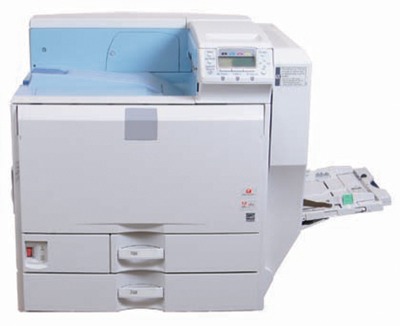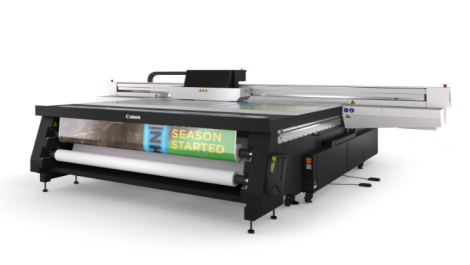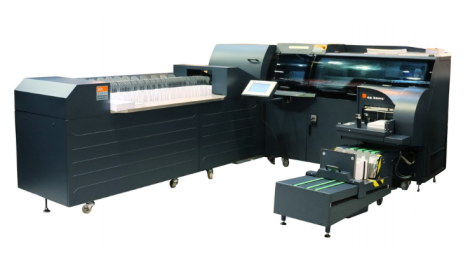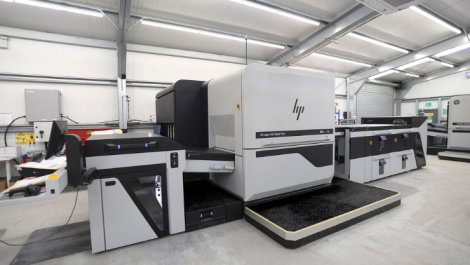There are a large number of options for those wishing to enter the digital printing arena, depending on their existing volumes, applications and customer demands.
What is an entry level digital press for a business that makes money from printing? There is no simple answer to that, as it entirely depends upon the volumes of printed output, the applications and their quality and media demands, and the power of the engine required. A 65-75 A4 pages per minute ‘light’ production press can be one man’s entry level press; for the next man, a 30 A4 pages per minute device may be sufficient.
Page rates per minute is also only one way of categorising these technologies – and a simplistic one at that. However, for the purposes of this article, and to attempt to retain that simplicity, it will be the method of initial comparison. There are at least two, and quite probably more, markets encompassed here therefore. It makes sense to start with OKI as, despite being better known in the office space, its higher end technology is also used by companies such as Intec Printing Solutions, DTP Associates, ECRM and Xanté (for the Illumina) on an OEM basis, upon which to develop specialist functionality.
The OKI ES9410 is suitable for a wide range of marketing collateral, banners and general jobbing work. It can print 31 colour A4 pages per minute, with a heaviest stock capability of 300 gsm. It can print on both sides of the sheet as standard and on media sizes up to 328 mm wide by 1.2 metres long, delivering 1200 dpi resolution. It has a PostScript driver but is compatible with EFI’s Colorproof XF colour management RIP (so can be used for proofing), and Fiery XF Production RIP. The ES9410 (as featured in Digital Printer May 2010) is priced at £6,000 and upwards. If you want to print onto heavier stock, then the OKI-based Intec XP2020 has the edge. While its performance is identical to the OKI ES9410 printer in many respects, Intec’s printer can print onto substrates up to a grammage of 600 gsm. It is also a bit quicker at 2,000 prints per hour (36 pages per minute), and has a higher monthly duty cycle of 150,000 A4 pages. The RIP is different too – a Harlequin-based RIP with enhanced colour management and screening. DTP Associates’ X-Press OnDemand 2400, DuraPress and 4800 devices, again built around the OKI technology, are all available on lease terms. These are rated for 36 pages per minute, and can print on SRA3 and banner size sheets (327 x 1200 mm). Print resolution takes a leap though, with both 2400 and 4800 dpi possible oncertain models.
OKI’s engine has also been repurposed for the ECRM DPP 1200, sold in the UK by Apex Digital Graphics. It uses ECRM’s Harlequinbased RIPMate and WorkMates software solutions, providing ‘offset screening and quality’, up to 175 lpi. The workflow can handle work for the digital press as well as conventional offset work for hybrid printing environments, with ICC profiling tools to help manage colour between the two processes. The monthly duty cycle is the same as for the Intec device – 150,000 A4 pages maximum.
Stepping up a level is the Xanté Impressia, aimed at small to medium run lengths in commercial print shops and in-house printers in corporate and public sector organisations. It has a top print speed of 50 pages per minute, full colour, and a quality boost up to 2400 dpi. Xanté says the Impressia can be used for a wide range of applications – letterheads, cards, envelopes, brochures, mailers, labels and banners included. It uses the company’s iQueue Ultimate Workflow which includes colour correction to match spot colours, imposition, job costing and a new QR code generator. In terms of media choices, the heaviest option is a 320 gsm sheet, while, using a bypass tray, a 304 mm x 1.2 metre sheet can be printed. This tray is also used as a feeder for envelopes and labels. The Impressia costs about £11,000 (€13,000). For heavier stock capability, Xanté also has the Illumina, which extends this aspect to 650 gsm, and is priced at about the same level. All of these entry level digital devices can be extended with extra paper trays and various finishing options – for example, the OKI ES9410 has optional automatic hole-punching, folding, saddle stitching and booklet making.
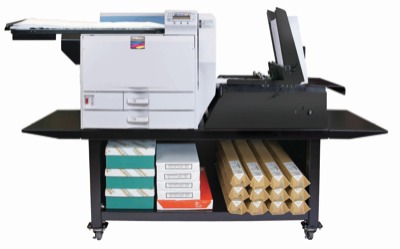 The Xant’e Impressia print at 2400 dpi
The Xant’e Impressia print at 2400 dpi
See the light
If true light production starts at 65 pages per minute, then that’s next to consider. Toshiba has a 65 colour pages per minute multi-functional printing system, driven by EFI Fiery, which it calls the e-Studio 6550CSE Pro. This prints mono at 75 pages per minute. Media up to 300 gsm can be printed via the bypass tray, as can banner size papers up to 1.2 metre in length. The cassettes accept SRA3 size. A host of big names enter the market at around this point, chiefly Canon, Konica Minolta (whose re-badged machines are also sold as the Develop range of Ineo systems by DSales), Ricoh (Heidelberg Linoprint) and Xerox. All of these of course have printing and multi-functional devices that cover a swathe of office markets and on up into light production and beyond. A quick straw poll of these manufacturers provides a breakdown of those systems that they consider to be within the entry level/light production category.
Canon has its imageRunner Advance 8000 and 9000 Pro Series machines, the second generation of which were launched last year. Top of the tree here is the C9280 Pro, a 70 pages per minute colour press with EFI Fiery System 10 server, and new on-demand fusing technology. Prices start at around £46,000. Konica Minolta cites its bizhubs Pro C754, and C6000 and C7000 presses. These last two have output ratings of 60 and 71 colour pages per minute respectively, paper handling to 300 gsm, 1200 x 1200 dpi resolution, and advanced colour processing technology, such as FM screening, and density control. Light production for Ricoh means the Pro C651EX and Pro C751 and C751EX (the EX machines are scanner models).
These are 65 and 75 pages per minute respectively. The manufacturer’s VCSEL (Vertical Cavity Surface Emitting Laser) technology and PxP polymerised toner,enables print quality of 4800 x 1200 dpi. Xerox lists the Color 550, 560 and C75 presses for entry level colour. The latter is a brand new press set to launch in March, printing at 75 pages per minute on 300 gsm paper stocks (51 ppm on coated stocks), and featuring the new Simple Image Quality Adjustment (SIQA) toolset, for automated registration control and density uniformity. There are choices up and down the spectrum of entry level digital presses therefore, and opportunities to upgrade as business grows. It all starts with customer demand though.
Light production commentary – Gareth Parker, Ricoh
‘I would say we see the light production market in terms of monthly volumes from around 80,000 up to around 200,000 pages per month. It’s not that simple though: you have to look towards the applications, the customer demand, and the technology and workflow that sit behind a genuine light production press. There are other key drivers of the light production market: SRA3 capability, registration and media capability, as examples. We have the high end office systems as well, but they lack some of the key features that you would expect from production print capability – SRA3 being one example; RIP power; colour management is a brilliant example of how you would trade up. There are gaps in the market place between office and light production, and our R&D will try to address those gaps.
There is an emerging market sector there I would suspect – customer types that are outgrowing what the high end office machine can provide – and developments that are still to be made. It’s down to the market to raise the topic and talk about it, understand the demand and develop something. We are aware of the gap and we are looking at it quite closely. The other main trend is the wider one of transition of a certain volume from offset to digital. Offset printers have an opportunity to evaluate whereabouts they can enter the digital market. At a certain volume and customer demand there’s a model where it is more cost effective to look at light production digital. When that’s happening with someone who has an offset mentality and skills, they would recognise the capabilities of a genuine production press.’
 Gareth Parker
Gareth Parker
